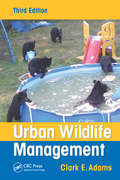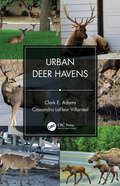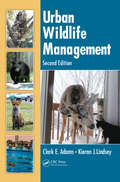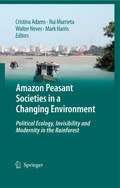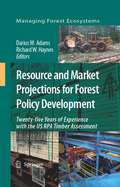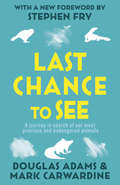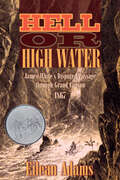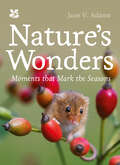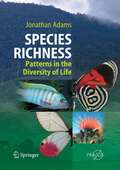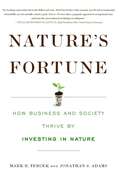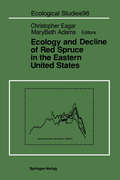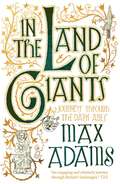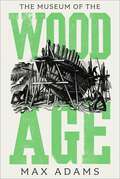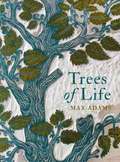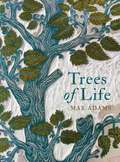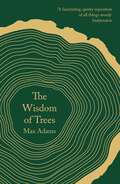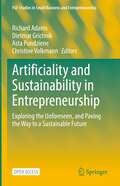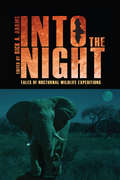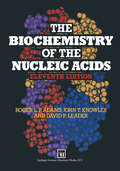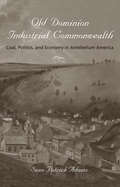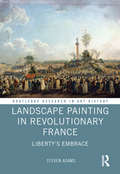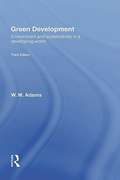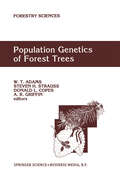- Table View
- List View
Urban Wildlife Management
by Clark E. AdamsWinner of the 2018 TWS Wildlife Publication Awards in the authored book category Urban development is one of the leading worldwide threats to conserving biodiversity. In the near future, wildlife management in urban landscapes will be a prominent issue for wildlife professionals. This new edition of Urban Wildlife Management continues the work of its predecessors by providing a comprehensive examination of the issues that increase the need for urban wildlife management, exploring the changing dynamics of the field while giving historical perspectives and looking at current trends and future directions. The book examines a range of topics on human interactions with wildlife in urbanized environments. It focuses not only on ecological matters but also on political, economic, and societal issues that must be addressed for successful management planning. This edition features an entirely new section on urban wildlife species, including chapters on urban communities, herpetofauna, birds, ungulates, mammals, carnivores, and feral and introduced species. The third edition features Five new chapters 12 updated chapters Four new case studies Seven new appendices and species profiles 90 new figures A comprehensive analysis of terrestrial vertebrate locations by state and urban observations Each chapter opens with a set of key concepts which are then examined in the following discussions. Suggested learning experiences to enhance knowledge conclude each chapter. The species profiles cover not only data about the animal concerned but also detail significant current management issues related to the species. An updated and expanded teaching tool, Urban Wildlife Management, Third Edition identifies the challenges and opportunities facing wildlife in urban communities as well as factors that promote or threaten their presence. It gives both students and professionals a solid grounding in the required fundamental ecological principles for understanding the effects of human-made environments on wildlife.
Urban Deer Havens
by Clark E. Adams Cassandra LaFleur VillarrealUrban Deer Havens consists of a thorough examination of selected cervid (deer) species that are known to inhabit urban communities in the United States. The deer species that are included in this presentation consisted of white-tailed (Odocoileus virginianus), Key deer (O. v. clavium), moose (Alces alces), elk (Cervus elaphus), mule (Odocoileus hemionus), and black-tailed deer (O. h. columbianus). This book is the first attempt to examine the similarities and differences in those factors that allow the selected cervids to exist and thrive in urban habitats. This information has never been collected, collated, reviewed, and published under one cover document. Yet, all five are known to inhabit urban communities within their geographic range. The lack of information concerning several important examples of urban cervids in conjunction with a proliferation of information on white-tailed deer only is an incomplete and biased presentation. This book is the first comprehensive source of information on urban deer management, which includes a broad assemblage of urban cervids. The overall objective of this book is to provide a more holistic examination of urban cervids. For example, it examines the similarities and differences of the environmental impacts, management strategies, and human dimensions considerations concerning urban cervids in general, and using specific examples. Urban Deer Havens features four chapters that include: Urban deer census techniques and population dynamics Comprehensive tables that review urban community deer management plans National and state-wide estimates the five selected cervids Laws and regulations concerning urban deer Lethal and nonlethal management options for managing deer Steps for managing urban deer populations Examples of urban deer management efforts
Urban Deer Havens
by Clark E. Adams Cassandra LaFleur VillarrealUrban Deer Havens consists of a thorough examination of selected cervid (deer) species that are known to inhabit urban communities in the United States. The deer species that are included in this presentation consisted of white-tailed (Odocoileus virginianus), Key deer (O. v. clavium), moose (Alces alces), elk (Cervus elaphus), mule (Odocoileus hemionus), and black-tailed deer (O. h. columbianus). This book is the first attempt to examine the similarities and differences in those factors that allow the selected cervids to exist and thrive in urban habitats. This information has never been collected, collated, reviewed, and published under one cover document. Yet, all five are known to inhabit urban communities within their geographic range. The lack of information concerning several important examples of urban cervids in conjunction with a proliferation of information on white-tailed deer only is an incomplete and biased presentation. This book is the first comprehensive source of information on urban deer management, which includes a broad assemblage of urban cervids. The overall objective of this book is to provide a more holistic examination of urban cervids. For example, it examines the similarities and differences of the environmental impacts, management strategies, and human dimensions considerations concerning urban cervids in general, and using specific examples. Urban Deer Havens features four chapters that include: Urban deer census techniques and population dynamics Comprehensive tables that review urban community deer management plans National and state-wide estimates the five selected cervids Laws and regulations concerning urban deer Lethal and nonlethal management options for managing deer Steps for managing urban deer populations Examples of urban deer management efforts
Urban Wildlife Management
by Clark E. Adams Kieran J. LindseyWhen the first edition of Urban Wildlife Management was published two years ago, it provided conservationists, ecologists, and wildlife professionals with a welcome shift in the way that interactions between humans and wildlife were viewed and managed. Instead of focusing on ways to evict or eradicate wildlife encroached on by urban development, th
Amazon Peasant Societies in a Changing Environment: Political Ecology, Invisibility and Modernity in the Rainforest
by Cristina Adams Mark Harris Rui S. S. Murrieta Walter A. NevesAmazonia is never quite what it seems. Despite regular attention in the media and numerous academic studies the Brazilian Amazon is rarely appreciated as a historical place home to a range of different societies. Often left invisible are the families who are making a living from the rivers and forests of the region. Broadly characterizing these people as peasants Amazon Peasant Societies in a Changing Environment seeks to bring together research by anthropologists, historians, political ecologists and biologists. A new paradigm emerges which helps understand the way in which Amazonian modernity has developed. This book addresses a comprehensive range of questions from the politics of conservation and sustainable development to the organization of women’s work and the diet and health of Amazonian people. Apart from offering an analysis of a neglected aspect of Amazonia this collection represents a unique interdisciplinary exercise on the nature of one of the most beguiling regions of the world.
Resource and Market Projections for Forest Policy Development: Twenty-five Years of Experience with the US RPA Timber Assessment (Managing Forest Ecosystems #14)
by Darius M. Adams Richard W. HaynesThe text provides literature surveys on relevant modeling issues and policy concerns. It demonstrates the application of a modeling system using a "base case" 50-year projection and a small set of scenarios. These illustrate, for example, the effects of changes in public harvest policies, variations in investments in silviculture, and globalization. It is aimed at policy makers, researchers and graduate students who are building or using forest sector models.
Last Chance To See
by Douglas Adams Mark Carwardine'Douglas Adams' genius was in using comedy to make serious points about the world' IndependentAfter years of reflecting on the absurdities of life on other planets, Douglas Adams teamed up with zoologist Mark Carwardine to find out what was happening to life on this one. Together they lead us on an unforgettable journey across the world in search of exotic, endangered creatures - animals that they may never get another chance to see. They encounter the animal kingdom in its stunning beauty, astonishing variety, and imminent peril: the giant Komodo dragon of Indonesia, the helpless but lovable Kakapo of New Zealand, the blind river dolphins of China, the white rhinos of Zaire, the rare birds of Mauritius island in the Indian Ocean. Both funny and poignant, Last Chance to See is the tale of an unforgettable wildlife odyssey - and a timely reminder of all that we must protect.
Hell Or High Water: James White's Disputed Passage through Grand Canyon, 1867 (G - Reference, Information And Interdisciplinary Subjects Ser.)
by Eilean AdamsAlthough John Wesley Powell and party are usually given credit for the first river descent through the Grand Canyon, the ghost of James White has haunted those claims. White was a Colorado prospector, who, almost two years before Powell's journey, washed up on a makeshift raft at Callville, Nevada. His claim to have entered the Colorado above the San Juan River with another man (soon drowned) as they fled from Indians was widely disseminated and believed for a time, but Powell and his successors on the river publically discounted it. Colorado River runners and historians have since debated whether White's passage through Grand Canyon even could have happened. Hell or High Water is the first full account of White's story and how it became distorted and he disparaged over time. It is also a fascinating detective story, recounting how White's granddaughter, Eilean Adams, over decades and with the assistance of a couple of notable Colorado River historians who believed he could have done what he claimed, gradually uncovered the record of James White's adventure and put together a plausible narrative of how and why he ended up floating helplessly down a turbulent river, entrenched in massive cliffs, with nothing but a driftwood raft to carry him through.
Nature’s Wonders: Moments that mark the seasons (National Trust)
by Jane V. Adams National Trust BooksBritain’s nature year, from the first flower to the last leaf
Species Richness: Patterns in the Diversity of Life (Springer Praxis Books)
by Jonathan AdamsThis is a readable, informative and up-to-date account of the patterns and controls on biodiversity. The author describes major trends in species richness, along with uncertainties in current knowledge. The various possible explanations for past and present species patterns are discussed and explained in an even-handed and accessible way. The implications of global climate change and habitat loss are considered, along with current strategies for preserving what we have. This book examines the state of current understanding of species richness patterns and their explanations. As well as the present day world, it deals with diversification and extinction, in the conservation of species richness, and the difficulties of assessing how many species remain to be discovered. The scientifically compelling subject of vegetation-climate interaction is considered in depth. Written in an accessible style, the author offers an up-to-date, rigorous and yet eminently comprehensible overview of the ecology and biogeography of species richness. He departs from the often heavy approach of earlier texts, without sacrificing rigor and depth of information and analysis. Prefacing with the aims of the book, Chapter 1 opens with an explanation of latitudinal gradients, including a description of major features of the striking gradients in species richness, exceptions to the rule, explanations, major theories and field and experimental tests. The following chapter plumbs the depth of time, including the nature of the fossil record, broad timescale diversity patterns, ecosystem changes during mass extinctions and glaciations and their influence on species richness. Chapters 3 and 4 consider hotspots and local scale patterns in species richness while Chapter 5 looks at the limitations and uncertainties on current estimates of richness, the last frontiers of species diversity and the process of identifying new life forms. The last three chapters cover humans and extinctions in history and prehistory, current habitat and global change, including the greenhouse effect, and the race to preserve what we still have, including parks, gene banks and laws.
Nature's Fortune: How Business and Society Thrive by Investing in Nature
by Jonathan S. Adams Mark R. TercekWhat is nature worth? The answer to this question-which traditionally has been framed in environmental terms-is revolutionizing the way we do business.In Nature's Fortune, Mark Tercek, CEO of The Nature Conservancy and former investment banker, and science writer Jonathan Adams argue that nature is not only the foundation of human well-being, but also the smartest commercial investment any business or government can make. The forests, floodplains, and oyster reefs often seen simply as raw materials or as obstacles to be cleared in the name of progress are, instead, as important to our future prosperity as technology or law or business innovation.Who invests in nature, and why? What rates of return can it produce? When is protecting nature a good investment? With stories from the South Pacific to the California coast, from the Andes to the Gulf of Mexico and even to New York City, Nature's Fortune shows how viewing nature as green infrastructure allows for breakthroughs not only in conservation-protecting water supplies; enhancing the health of fisheries; making cities more sustainable, livable and safe; and dealing with unavoidable climate change-but in economic progress, as well. Organizations obviously depend on the environment for key resources-water, trees, and land. But they can also reap substantial commercial benefits in the form of risk mitigation, cost reduction, new investment opportunities, and the protection of assets. Once leaders learn how to account for nature in financial terms, they can incorporate that value into the organization's decisions and activities, just as habitually as they consider cost, revenue, and ROI. Such a rethinking of "natural capital”-nature as a quantifiable asset-can not only increase profitability, but provide crucial protection against the kinds of climate change-driven phenomena-like devastating drought and hundred-year floods-that are no longer the stuff of speculation.A must-read for business leaders, CEOs, investors, and environmentalists alike, Nature's Fortune offers an essential guide to the world's economic-and environmental-well-being.
Ecology and Decline of Red Spruce in the Eastern United States (Ecological Studies #96)
by Mary B. Adams C. Cogbill E. R. Cook D. H. DeHayes Christopher Eagar I. J. Fernandez K. F. Jensen A. H. Johnson D. W. Johnson R. J. Kohut S. B. McLaughlin M.M. Miller-Weeks V. A. Mohnen N. S. Nicholas D. R. Peart G. A. Schier T. G. Siccama P. S. White S. M. ZedakerIn the early 1980s there were several published reports of recent, unexplained increases in mortality of red spruce in the Adirondack Mountains and the northern Appalachian Mountains of the eastern United States. These reports coincided with documentation of reductions in radial growth of several species of pine in the southeastern United States, and with the severe, rapid, and widespread decline of Norway spruce, silver fir, and some hardwoods in central Europe. In all of these instances, atmospheric deposition was hypothesized as the cause of the decline. (Throughout this volume, we use the term "decline" to refer to a loosely synchronized regional-scale deterioration of tree health which is brought about by a combination of stress factors. These may be biotic or abiotic in nature, and the combinations may differ from site to site. ) Heated public debate about the causes and possible cures for these forest declines ensued. Through the course of this debate, it became clear that information about forest health and air pollution effects on forests was inadequate to meet policymakers' needs. Ecology and Decline of Red Spruce in the Eastern United States addresses that gap for eastern spruce fir forests and represents the culmination of a great deal of research conducted in recent years. The focus is on red spruce because the decline of red spruce was both dramatic and inexplicable and because of the great amount of information gathered on red spruce.
In the Land of Giants
by Max AdamsThe bestselling historian tells the story of the landscapes, peoples and culture of early medieval Britain in eight walks, an epic sea voyage and a north-south ride by motorbike. The five centuries between the end of Roman Britain (410) and the death of Alfred the Great (899) have left few voices save a handful of chroniclers, but Britain's 'Dark Ages' can still be explored through their material remnants: buildings, books, metalwork, and, above all, landscapes. Adams explores Britain's lost early medieval past by walking its paths and exploring its imprint on valley, hill and field. From York to Whitby, London to Sutton Hoo and Falmouth to Mallaig, In the Land of Giants offers a beautifully written insight into the lives of peasants, drengs, ceorls, thanes, monks and kings during an enigmatic but richly exciting period of our island's history.
The Museum of the Wood Age
by Max AdamsA passionate and imaginative exploration of wood – the material that shaped human history.As a material, wood has no equal in strength, resilience, adaptability and availability. It has been our partner in the cultural evolution from woodland foragers to engineers of our own destiny. Tracing that partnership through tools, devices, construction and artistic expression, Max Adams explores the role that wood has played in our own history as an imaginative, curious and resourceful species.Beginning with an investigation of the material properties of various species of wood, The Museum of the Wood Age investigates the influence of six basic devices – wedge, inclined plane, screw, lever, wheel, axle and pulley – and in so doing reveals the myriad ways in which wood has been worked throughout human history. From the simple bivouacs of hunter-gatherers to sophisticated wooden buildings such as stave churches; from the decorative arts to the humble woodworking of rustic furniture; Max Adams fashions a lattice of interconnected stories and objects that trace a path of human ingenuity across half a million years of history.
Trees of Life
by Max AdamsAn informative, richly illustrated book about eighty of the world’s most important and remarkable treesOur planet is home to some three trillion trees—roughly four hundred for every person on Earth. In Trees of Life, Max Adams selects, from sixty thousand extant species, eighty remarkable trees through which to celebrate the richness of humanity’s relationship with trees, woods, and forests.In a sequence of informative and beautifully illustrated portraits, divided between six thematic sections, Adams investigates the trees that human cultures have found most useful across the world and ages: trees that yield timber and other materials of immense practical value, trees that bear edible fruits and nuts, trees that deliver special culinary ingredients and traditions, and trees that give us dyes, essences, and medicines. In a section titled “Supertrees,” Adams considers trees that have played a pivotal role in maintaining natural and social communities, while a final section, “Trees for the Planet,” looks at a group of trees so valuable to humanity that they must be protected at all costs from loss.From the apple to the oak, the logwood to the breadfruit, and the paper mulberry to the Dahurian larch, these are trees that offer not merely shelter, timber, and fuel but also drugs, foods, and fibers. Trees of Life presents a plethora of fascinating stories about them.
Trees of Life
by Max AdamsA captivatingly informative and visually beautiful survey of the tree species – from all over the world – that human cultures have found most useful. Each tree species is the subject of a concise text centred on a story – or stories – about the tree in question, and is depicted by means of a photograph, painting or other aesthetic artefact. The species will be organized thematically according to the virtues they impart, be that in the form of timber, nuts, fruit or medicine. The bloodwood tree, a native of central America, is a tree that made a nation. Its wood produces a brilliant and lucrative bright red dye and was imported to Europe for use in dyeing fabrics. The 17th and 18th-century logging camps established by the British later became the modern nation of Belize, and the bloodwood tree appears on its national flag. From the bloodwood to the breadfruit and from the cinchona to the peach, these are trees that offer not merely shelter, timber and fuel but also medicines, dyes, foods and fibres. They are very special trees, and Max Adams, author of The Wisdom of Trees, has a plethora of such fascinating stories to tell about them.
The Wisdom of Trees: A Miscellany
by Max AdamsA passionate and informative celebration of trees and of man's ingenuity in exploiting their resources: the perfect gift for anyone who cares about the natural world.Trees are marvels of nature, still-standing giants of extraordinary longevity. In a beautifully written sequence of essays, anecdotes and profiles of Britain's best-loved species (from yew to scots pine), Max Adams explores both the amazing biology of trees and humanity's relationship with wood and forest across the centuries.Embellished with images from John Evelyn's classic SYLVA (1664), THE WISDOM OF TREES is a gift book that will delight anyone who cares about the natural world and our interaction with it.
Artificiality and Sustainability in Entrepreneurship: Exploring the Unforeseen, and Paving the Way to a Sustainable Future (FGF Studies in Small Business and Entrepreneurship)
by Richard Adams Dietmar Grichnik Asta Pundziene Christine VolkmannThis open access edited volume explores the past, present, and future of artificiality and sustainability in entrepreneurship – the unforeseen consequences and ways to advance to a sustainable future. In particular, it connects artificiality, sustainability and entrepreneurship, intertwining artificial with the specific phenomenon of those novel digital technologies that provoke continuous and significant change in our lives and business. Unlike digital entrepreneurship research, which focuses on digital technology development and management, this book covers processes and mechanisms of sustainable adaptability of entrepreneurs, the business logic of start-ups, and the collaborative behaviours under the mass digital transformation, including the prevalence of artificial intelligence. Some of the questions that this book answers are as follows: How has entrepreneurship reacted to such challenges previously? What lessons have been learned and need to be carried forward? How can entrepreneurship and the artefacts of entrepreneurship respond to current challenges? What should be the mindset of the entrepreneur to assure sustainable adaptation? How to embrace and embed the new business logic?
Into the Night: Tales of Nocturnal Wildlife Expeditions
by Rick AdamsThis entertaining collection of essays from professional scientists and naturalists provides an enlightening look at the lives of field biologists with a passion for the hidden world of nocturnal wildlife. Into the Night explores the harrowing, fascinating, amusing, and largely unheard personal experiences of scientists willing to forsake the safety of daylight to document the natural history of these uniquely adapted animals. Contributors tell of confronting North American bears, cougars, and rattlesnakes; suffering red ctenid spider bites in the tropical rain forest; swimming through layers of feeding-frenzied hammerhead sharks in the Galapagos; evading the wrath of African bull elephants in South Africa; and delighting in the curious and gentle nature of foxes and unconditional acceptance by a family of owls. They describe “fire in the sky” across a treeless tundra, a sea ablaze with bioluminescent algae, nighttime earthquakes on the Pacific Rim, and hurricanes and erupting volcanoes on a Caribbean island. Into the Night reveals rare and unexpected insights into nocturnal field research, illuminating experiences, discoveries, and challenges faced by intrepid biologists studying nature’s nightly marvels across the globe. This volume will be of interest to scientists and general readers alike.
The Biochemistry of the Nucleic Acids
by R.L.P. Adams J.T. Knowler D.P. LeaderWhen the first edition of this book was published in 1950, it predated the publication of the double-helical structure of DNA by three years. It is not, therefore, surprizing that nothing of the original book remains in the current edition. Indeed, such is the pace of change in the field of nucleic acids that less than 50% of material incorporated into the 1986 edition has been retained. The book aims at the advanced undergraduate and at graduates that are undertaking course work or requiring an in-depth background for their research. It also aims to provide the established scientist with a single text that permits updating across the whole field from DNA structure, replication and repair, through gene expression and its control to protein synthesis. Every chapter is accompanied by thorough referencing that enables the reader to evaluate personally the data and methodology that cannot be included in the text. In an attempt to keep this list within bounds, references are limited to about ten per page and, to accommodate the more recent literature, many of the older references have been left out in this latest edition.
Old Dominion, Industrial Commonwealth: Coal, Politics, and Economy in Antebellum America (Studies in Early American Economy and Society from the Library Company of Philadelphia)
by Sean Patrick AdamsIn 1796, famed engineer and architect Benjamin Henry Latrobe toured the coal fields outside Richmond, Virginia, declaring enthusiastically, "Such a mine of Wealth exists, I believe, nowhere else!" With its abundant and accessible deposits, growing industries, and network of rivers and ports, Virginia stood poised to serve as the center of the young nation's coal trade. By the middle of the nineteenth century, however, Virginia's leadership in the American coal industry had completely unraveled while Pennsylvania, at first slow to exploit its vast reserves of anthracite and bituminous coal, had become the country's leading producer.Sean Patrick Adams compares the political economies of coal in Virginia and Pennsylvania from the late eighteenth century through the Civil War, examining the divergent paths these two states took in developing their ample coal reserves during a critical period of American industrialization. In both cases, Adams finds, state economic policies played a major role. Virginia's failure to exploit the rich coal fields in the western part of the state can be traced to the legislature's overriding concern to protect and promote the interests of the agrarian, slaveholding elite of eastern Virginia. Pennsylvania's more factious legislature enthusiastically embraced a policy of economic growth that resulted in the construction of an extensive transportation network, a statewide geological survey, and support for private investment in its coal fields.Using coal as a barometer of economic change, Old Dominion, Industrial Commonwealth addresses longstanding questions about North-South economic divergence and the role of state government in American industrial development, providing new insights for both political and economic historians of nineteenth-century America.
Landscape Painting in Revolutionary France: Liberty's Embrace (Routledge Research in Art History)
by Steven AdamsThe French Revolution had a marked impact on the ways in which citizens saw the newly liberated spaces in which they now lived. Painting, gardening, cinematic displays of landscape, travel guides, public festivals, and tales of space flight and devilabduction each shaped citizens’ understanding of space. Through an exploration of landscape painting over some 40 years, Steven Adams examines the work of artists, critics and contemporary observers who have largely escaped art historical attention to show the importance of landscape as a means of crystallising national identity in a period of unprecedented political and social change.
Landscape Painting in Revolutionary France: Liberty's Embrace (Routledge Research in Art History)
by Steven AdamsThe French Revolution had a marked impact on the ways in which citizens saw the newly liberated spaces in which they now lived. Painting, gardening, cinematic displays of landscape, travel guides, public festivals, and tales of space flight and devilabduction each shaped citizens’ understanding of space. Through an exploration of landscape painting over some 40 years, Steven Adams examines the work of artists, critics and contemporary observers who have largely escaped art historical attention to show the importance of landscape as a means of crystallising national identity in a period of unprecedented political and social change.
Green Development: Environment and Sustainability in a Developing World (PDF)
by W. M. AdamsThe concept of sustainability lies at the core of the challenge of environment and development and the way governments, business and environmental groups respond to it. Green Developmentprovides a clear and coherent analysis of sustainable development in both theory and practice. This third edition retains the clear and powerful argument of previous editions, but has been updated to reflect advances in ideas and changes in international policy. Greater attention has been given to political ecology, environmental risk and the environmental impacts of development. This fully revised third edition discusses: the origins of thinking about sustainability and sustainable development and its evolution to the present day the ideas that dominate mainstream sustainable development (ecological modernization, market environmentalism and environmental economics) the nature and diversity of alternative ideas about sustainability that challenge 'business as usual' thinking (for example ecosocialism, ecofeminism, deep ecology and political ecology) the dilemmas of sustainability in the context of dryland degradation, deforestation, biodiversity conservation, dam construction and urban and industrial development the nature of policy choices about the environment and development strategies and between reformist and radical responses to the contemporary global dilemmas. Green Developmentoffers clear insights into the challenges of environmental sustainability and social and economic development. It is unique in offering a synthesis of theoretical ideas on sustainability and in its coverage of the extensive literature on the environment and development around the world. This book has proved its value to generations of students as an authoritative, thought-provoking and readable guide to the field of sustainable development.
Population Genetics of Forest Trees: Proceedings of the International Symposium on Population Genetics of Forest Trees Corvallis, Oregon, U.S.A., July 31-August 2,1990 (Forestry Sciences #42)
by W. T. Adams Steven H. Strauss Donald L. Copes A. R. GriffinTropical climates, which occur between 23°30'N and S latitude (Jacob 1988), encompass a wide variety of plant communities (Hartshorn 1983, 1988), many of which are diverse in their woody floras. Within this geographic region, temperature and the amount and seasonality of rainfall define habitat types (UNESCO 1978). The F AO has estimated that there 1 are about 19 million km of potentially forested area in the global tropics, of which 58% were estimated to still be in closed forest in the mid-1970s (Sommers 1976; UNESCO 1978). Of this potentially forested region, 42% is categorized as dry forest lifezone, 33% is tropical moist forest, and 25% is wet or rain forest (Lugo 1988). The species diversity of these tropical habitats is very high. Raven (1976, in Mooney 1988) estimated that 65% of the 250,000 or more plant species of the earth are found in tropical regions. Of this floristic assemblage, a large fraction are woody species. In the well-collected tropical moist forest of Barro Colorado Island, Panama, 39. 7% (481 of 1212 species) of the native phanerogams are woody, arborescent species (Croat 1978). Another 21. 9% are woody vines and lianas. Southeast Asian Dipterocarp forests may contain 120-200 species of trees per hectare (Whitmore 1984), and recent surveys in upper Amazonia re corded from 89 to 283 woody species ~ 10 cm dbh per hectare (Gentry 1988). Tropical communities thus represent a global woody flora of significant scope.
